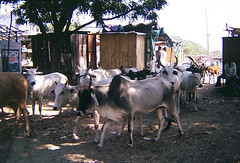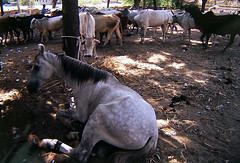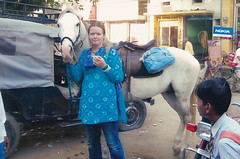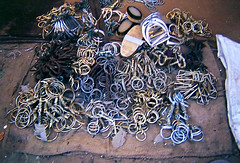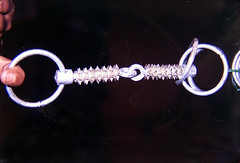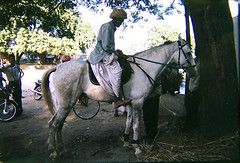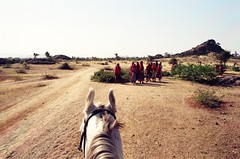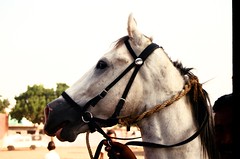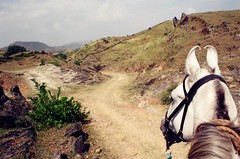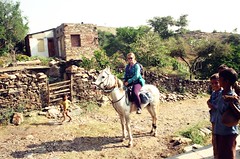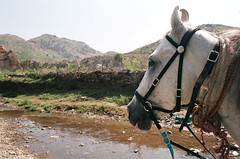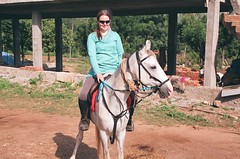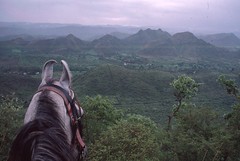And so Chandra was sleeping, I was drinking tea and it was two hours until the pickup truck was due to collect us. Then a mare trots down the road and wakes up poor Chandra with her calls. I asked the locals to stop her from entering the enclosure through the gap in the picture above while I tried to calm poor old Chandra down. Despite never having covered a mare, he has a very good idea of what it's all about and as he is now sexually mature the frustration can get the better of the poor guy.
Then to my horror, rather than chase the mare away, the villagers actively herded her in towards my stallion! I went to shoo her and she turned round and aimed a kick at my head that gracefully missed. She was in heat, and one of those mare who is aggressive when in heat, so she was trying to get to Chandra, or to attack me if I got in the way, I was screaming for help, someone to bring a stick, anything, find the owner and the villagers all stood round, blocking the exit and staring on the scene as immobile as statues oblivious to my increasingly panicked requests for help. Chandra was on the verge of mounting the homicidal mare when I managed to find a wooden post to chase her off with, but still the villagers blocked the exit, refused to catch her and made the situation much worse that it would have been out in the open (I managed to ride past loose mares without too much incident twice on the road). Then the mare started lunging at me again so, I'm not proud but I picked up the closest thing to hand, a chair and threw it at her. That and the huge heavy wooden post managed to get her away from Chandra and I got her through the villagers and away from my horse. Then the villagers started telling me to chill out, what's the problem, oh we can't help because we're all afraid of horses, it's not the owners fault that the rope broke. Interestingly an hour after he sees that there is a valuable purebred, tall Marwari stallion in the village his mare breaks her rope...and there was no trace of broken rope on her...A mating with Chandra would cost R5000, his mare is short and mixed so he would make a pretty penny off of the offspring of my stallion. Besides I'm only a woman, what would a woman do? A woman and a horse, pah, so goes the village logic. If I were a man no such thing would happen.
Poor Chandra was very frustrated by the whole fiasco and I got my things together, tacked up and rode off in record time despite my fever, abscess and pain and we rode back to Bur, 6kms away with me hyperventilating half the way from the shock and stress of it all. I was lucky, mostly stallions who are sexually frustrated like that will bite or rear and box with their front hooves to assert their dominance and frustration over the situation. I am lucky enough to own one of the few stallions that can be ridden away without trouble after such an event.
This event did have a lasting effect on Chandra's behaviour though; he rears more, and is much more sexually frustrated than before. Meaning that it was impossible to ride him in the Pushkar grounds, as soon as he saw all those mares he reared and reared. Not in an aggressive way, it's a natural thing, stallions showing off to mares. I'd rather his introduction to the world of mating to be better though. My friend Rafeek is a horse training near Ajmer, he has three stallions that understand when mating behaviour is appropriate and when it's not. I'm debating sending Chandra to him for mating training when I have money. If he starts with good habits then it is much kinder than letting him get bad habits and then trying to correct them.
Monday, 15 December 2008
Monday, 8 December 2008
Chandra rests before the drama begins...
And so we reached Bhotaliya, well a temple with a load of chai shops and the usual village madman wandering about shouting. Foucault would have a field day watching the insane in India. The attitude is not one of medicalisation, that the “mad” must be hospitalised and treated, it’s accepted as normal; “half mind” or “mind crack” are used to describe the babbling lunatics of whom there is always at least one in each village. In this one he herded cattle, and danced and ranted and sang nonsense. As long as he stayed away from my horse I didn’t care. So I tied Chandra to a tree behind the shops. There were walls on either side and at the back and so only a narrow entrance, it seemed secluded and peaceful. I was in too much pain to do anything, to put it in context: my leg had swollen from ankle to knee and was more painful than the two I had operated on here, for which I was given morphine and all I had there was some ibuprofen. My boyfriend John called from England and managed to convince me that my stubborn pride in wanting to ride the remaining 60kms to Govindgargh was not worth risking losing a leg to infection over. So I arranged for a pick up truck as I couldn’t ride anymore, it was to be three hours so I sat and drank more chai. A local came by who owns a mare, then we went away. An hour later a mare in heat came trotting down the road.
The final day
After nine days I had arrived in Raipur, which in itself was a saga. As predicted, Chandra's shoes had worn out. Beawar city was two days ride away and Raipur was on the way. The locals seemed convinced that there was a farrier in Raipur, which was preferable as it is a smaller city and involved less of a detour. My host from Buda Guda village had given me a fantastic route of quiet tracks avoiding the main roads to Raipur. Indeed the first ten kms were sandy tracks, the villages were far apart and there were hardly any people. But then we came upon roads that were tarmac, fresh and soft, oh yes madam you are very lucky this is new road, why only three days ago it was a horrible dirt track, isn’t’ it great now it’s paved? Indeed….The curse of progress, the black tar intrudes into the wilderness bringing traffic and noise with it. And so we arrived in Raipur, by which stage Chandra had lost half of each shoe in the back, making the wear on his hooves uneven and therefore in need of swift repair to avoid having his legs held in unnatural angles. Half the town said there was no farrier, half the town said there was, no one could give a straight answer. After an hours searching I managed to find the town horse man who had shoes and tools with him. So he took off the old shoes, and then put on new ones without adjusting the hooves for uneven wear, or reshaping the shoes to fit the hoof!!!! And so one side had the bars of the shoe sticking out a good inch behind Chandra’s hoof and the other was crooked. Then to top it off he asked for more than the cost of four shoes in Udaipur just for his awful job on two.
That night Chandra got the accommodation he deserved; he stayed in the stable of the old village fort, with three gates and his own security guard. Not to mention the masses of food that he had. I meanwhile stayed with a cousin of Rafeek’s in the town. That night I took a shower and inspected my swollen right leg, at which point a little dot opened up and began pouring out lots of puss. With no decent hospital nearby all I could do was buy amoxicillin and hope I could ride the two days ride to Govindgargh where I could safely leave Chandra and then go to see a doctor in Pushkar.
The aim then on day ten was to ride 35kms to Babra, and sadly the only directions that anyone would give me for the first 7kms was to go on the highway. The highway full of heavy goods vehicles honking horns, over laden with overweight goods and driving like a blind pack of buffalos would run. Not my idea of a safe or fun time, and equally not Chandra’s as he spooked at the monsters that threatened to run us over. Whenever I asked anyone where there was a side road, or a quiet road, or any road in a general north-east direction that wasn’t the highway they thought I was mad. “madam you do one thing, you get rid ride of that horse and get a vehicle” is one of the responses that sticks in my memory for its idiocy. I saw a track goining north so I followed that, wilderness surrounded us with only the sound of the highway on the horizon annoying us for a few kms until we hit field walls and so had to return to the highway side, meaning that once I tried to get off it again all the villagers had to tell me “no you can’t go there, there’s no road! It’s jungle! Why don’t you go on the nice highway?” and they watched as if I was suicidal as I meandered my way through the wilderness. Eventually we reached Bar, an hour and a half later and we had only gone 7kms from where we had begun, my leg was throbbing, my knees were aching and Chandra was wound up and tense from all the traffic noise. The next village Bhotaliya was 7kms on.
That night Chandra got the accommodation he deserved; he stayed in the stable of the old village fort, with three gates and his own security guard. Not to mention the masses of food that he had. I meanwhile stayed with a cousin of Rafeek’s in the town. That night I took a shower and inspected my swollen right leg, at which point a little dot opened up and began pouring out lots of puss. With no decent hospital nearby all I could do was buy amoxicillin and hope I could ride the two days ride to Govindgargh where I could safely leave Chandra and then go to see a doctor in Pushkar.
The aim then on day ten was to ride 35kms to Babra, and sadly the only directions that anyone would give me for the first 7kms was to go on the highway. The highway full of heavy goods vehicles honking horns, over laden with overweight goods and driving like a blind pack of buffalos would run. Not my idea of a safe or fun time, and equally not Chandra’s as he spooked at the monsters that threatened to run us over. Whenever I asked anyone where there was a side road, or a quiet road, or any road in a general north-east direction that wasn’t the highway they thought I was mad. “madam you do one thing, you get rid ride of that horse and get a vehicle” is one of the responses that sticks in my memory for its idiocy. I saw a track goining north so I followed that, wilderness surrounded us with only the sound of the highway on the horizon annoying us for a few kms until we hit field walls and so had to return to the highway side, meaning that once I tried to get off it again all the villagers had to tell me “no you can’t go there, there’s no road! It’s jungle! Why don’t you go on the nice highway?” and they watched as if I was suicidal as I meandered my way through the wilderness. Eventually we reached Bar, an hour and a half later and we had only gone 7kms from where we had begun, my leg was throbbing, my knees were aching and Chandra was wound up and tense from all the traffic noise. The next village Bhotaliya was 7kms on.
Khimara
Chandra and I all tacked up and ready to go. It's amazing how little possesions one can get by on, the saddle bags were entirely Chandra's things: rope, head collar, wind-sucking collar, brushes, creams, first aid kit, food and wormers, the bag on my back had only a change of clothes, some soap and my camera.
Khimara2
I was lucky enough to get these, the only decent photos I have of Chandra and I thanks to a journalist in Khemara. They took my photo on a digital camera and luckily there was a photo shop in the town where I got two prints made.
Thursday, 4 December 2008
Some of the seemingly endless plains
After the hills and stones of Udaipur and around it felt like a dream come true to have sand and plains. In such areas the distance between villages is greater, due to a lack of water much of the land is barren and open and so it's great for riding. Often I would ride in the plains near the road, keeping the black tar in my line of vision as a navigation tool but avoiding riding on it as much as possible. Which Chandra appreciated one day when we encountered a herd of a couple hundred cattle walking down the road to a government cow shelter. He stood stock still, raised his head and make the most bizarre snorting noise. It was part aggressive, part terrified and he wouldn't move an inch until they were all quite far away. I find this funny as all horses are supposed to have an inbuilt fear of the smell of pigs, some sort of evolutionary survival tactic that saved them in the days when wild boars were a threat to them. Not my Chandra though, he will happily walk inches past several pigs running about and snorting but the second he sees a cow or buffalo he is petrified.
pushkar2008
pushkar2008
Indian bits in a shop
Just to give a wider picture, this is a selection of bits with various degrees of sharpness, none of them smooth. Snaffles and pelhems are available in this shop but nobody buys them so they don't get displayed out front.
The reason I chose to go bitless....
This here is a standard Indian bit, and it feels every bit as sharp as it looks. It is normal for a horse to have the sides of its lips torn and bleeding after each time it is ridden, even if only for a few minutes. Of course this renders their mouths so calloused that they can never be ridden with a simple snaffle without time and patience to retrain them to respond to seat and voice aids.
Chandra converting an old man to going bitless
When riding from Khemara I had no contact set up within the next 50kms and so left in the morning with the exhilarating lack of knowledge of where we would end up that night. Three years ago Rani and I had stayed near Bhopari village but I had heard the horse people there had since moved everything to Devgargh. After a rest in Ranawas, where again the villagers attempted to feed Chandra half his body weight in green grass for next to nothing, I decided that a village north of there should be a good place to stop for the day. I asked the locals if they knew of any horse men in the next village and some people thought there was a Rajput with a horse so I went along there. Upon arriving it turned out the said Rajput was working away, he had no horses and his wife couldn't stand the dam things. So we had no where to go, so I did the usual magic trick, sit in the village square and wait five minutes for the offers to come pouring in. Which they did, Rajinder Singh from near Bhopari had met me three years before and was passing by so stopped to invite us round. Once there his father wanted to have a go on Chandra, utterly unbelieving that there was no bit in his mouth. He took a leap of faith and had a go and came back very impressed, while Chandra just looked confused and kept looking at me with a lost expression on his face, bless....
Tuesday, 2 December 2008
Lunch time rest at Muchalla Mandir, day 4
Day four saw us pass through the Khmbalgargh nature reserve, passing from the Rajsamand district into the Pali district, from the Aravelli mountains into the plains, dust and heat. The 12km ride through the nature reserve was without incident, we saw no wildlife, unlike in the Pali district where I saw a herd of 12 Nilgai once, a viper snake crushed on the road, lots of mongoose and some monitor lizards. When we reached the gate on the Pali district side a cute little dog adopted us after I fed it a chapatti. She loyally followed us for the 6kms to the Jain temple in this photo, where I tied Chandra up and we both had lunch and two hours rest before riding on to Narlai.
While digesting my Jain temple lunch, free from garlic, potatoes or onions as they are life forms and it would kill the plant to eat them, another dog came by. I have a photo somewhere of a dog I once found in a similar state, there really is no way that I can describe it other than that it was walking around with its brain falling out in a blackened and stinking cavity full of maggots where an ear or eye once was. It has been like that for some time, the locals chased him away with sticks and stones before I could get close to him.
From the temple it was 25kms ride to Ajit Singh's farm, and on the road we encountered a loose female horse for the second time that day (the first being near Khumbalgargh). Although very excited by the sight of another horse I managed to keep Chandra under control (without a bit too may I add!) and we eventually arrived at Ajit's stables at 4:30pm.
In that strange Indian way that makes my question my ideas of determinism, chance, coincidences and so on Dr Naveen had popped in to visit Ajit. Dr Naveen is a government vet from Desuri, a nearby town. Having graduated from Vet school in Bikaner he got the standard government job stationed in his hometown and settling into the tedium of artificial insemination of cows and helping farmers increase milk yield. His elder brother is also a vet however he went to work for Help in Suffering, a very good charity in Jaipur city, thanks to whom Jaipur is now a rabies free city for the first time, proving how effective the animal birth control and vaccination programs can be.
Anyways Dr Naveen's brother showed him how to de-sex dogs and so they started up their own little animal birth control program in their own free time, from their own pockets. Dr Naveen would catch a dog after tempting it with food and then operate on it, one per day meant that a couple hundred were done before people started to notice. Sadly the said people were Hindus, very religious Hindus, who formally complained that this doctor was depriving these dogs of the precious ability to give life without even getting their consent. So they moved Naveen and he began again, and again the Hindus noticed and complained. And so Naveen was told in no uncertain terms that if he didn't stop his silly hobby they'd station him out in the Jaisalmer or Barmer districts. And so he had to stop, although he still helps wounded dogs he finds and so I was able to tell him of that mornings dog and he promised to tell all vets in the area to carry an injection on them to put the dog to sleep when they found it. So the poor dog got lucky and his suffering was lessened thanks to some lucky coincidences on its part. Rabies is still a huge problem in the Pali district, ignorance aiding its spread.
While digesting my Jain temple lunch, free from garlic, potatoes or onions as they are life forms and it would kill the plant to eat them, another dog came by. I have a photo somewhere of a dog I once found in a similar state, there really is no way that I can describe it other than that it was walking around with its brain falling out in a blackened and stinking cavity full of maggots where an ear or eye once was. It has been like that for some time, the locals chased him away with sticks and stones before I could get close to him.
From the temple it was 25kms ride to Ajit Singh's farm, and on the road we encountered a loose female horse for the second time that day (the first being near Khumbalgargh). Although very excited by the sight of another horse I managed to keep Chandra under control (without a bit too may I add!) and we eventually arrived at Ajit's stables at 4:30pm.
In that strange Indian way that makes my question my ideas of determinism, chance, coincidences and so on Dr Naveen had popped in to visit Ajit. Dr Naveen is a government vet from Desuri, a nearby town. Having graduated from Vet school in Bikaner he got the standard government job stationed in his hometown and settling into the tedium of artificial insemination of cows and helping farmers increase milk yield. His elder brother is also a vet however he went to work for Help in Suffering, a very good charity in Jaipur city, thanks to whom Jaipur is now a rabies free city for the first time, proving how effective the animal birth control and vaccination programs can be.
Anyways Dr Naveen's brother showed him how to de-sex dogs and so they started up their own little animal birth control program in their own free time, from their own pockets. Dr Naveen would catch a dog after tempting it with food and then operate on it, one per day meant that a couple hundred were done before people started to notice. Sadly the said people were Hindus, very religious Hindus, who formally complained that this doctor was depriving these dogs of the precious ability to give life without even getting their consent. So they moved Naveen and he began again, and again the Hindus noticed and complained. And so Naveen was told in no uncertain terms that if he didn't stop his silly hobby they'd station him out in the Jaisalmer or Barmer districts. And so he had to stop, although he still helps wounded dogs he finds and so I was able to tell him of that mornings dog and he promised to tell all vets in the area to carry an injection on them to put the dog to sleep when they found it. So the poor dog got lucky and his suffering was lessened thanks to some lucky coincidences on its part. Rabies is still a huge problem in the Pali district, ignorance aiding its spread.
Day 5, into the sandy plains
The ride from Narlai to Thakur ji ki Guda, 45+km that day. After having a days rest at Ajit Singh's stables in Narlai I got up at 5:30 to feed Chandra, who as ever is one of the slowest eating horses I have ever encountered, meaning we finally set off at 7:30am, later than I'd have liked if we were to avoid the mid-day heat. In the Pali district the mid-day temperatures were in the mid thirties and without shade. That day was especially hot, with the mid day sun blinding us, even with a headscarf and sunglasses. To make matters worse one wrong turn resulted in a 12km detour-7/8 in the wrong direction and then a different route to get back on track. We had only gotten 30 or so kilometres from where we left despite riding over 45kms that day and so when we reached a village 1km outside of Khimara city I got off and asked the locals about getting some alfalfa grass. Which of course resulted in invitations for both of us and Chandra receiving half his body weight in lush green grass for about 20 rupees (30 pence or so). That night Chandra got a water buffalo stable all to himself so had grain, grass and water to gorge on to his hearts content once he got used to the strange smells. Chandra seemingly is the only horse in India who is terrified of water buffalo- quite possibly the most dim witted creatures to survive evolution without killing themselves. Although that said I once saw one run off a cliff edge as it wasn't looking where it was going but that's another story....
The interesting thing I learned staying in that village is that the kids schools actually have very good english books, better than "Language to go" or "Cutting Edge" from my CELTA course but the high standard of educational materials is somewhat let down by the fact that the teachers don't speak the language that they are teaching! A situation I saw echoed throughout the homes I visited. The children are expected to teach themselves or possibly teachers expect the knowledge to magically move from page to child's brain with no effort on their part.
The interesting thing I learned staying in that village is that the kids schools actually have very good english books, better than "Language to go" or "Cutting Edge" from my CELTA course but the high standard of educational materials is somewhat let down by the fact that the teachers don't speak the language that they are teaching! A situation I saw echoed throughout the homes I visited. The children are expected to teach themselves or possibly teachers expect the knowledge to magically move from page to child's brain with no effort on their part.
I do have a proper excuse this time
Yes dear readers, I have been tardy in updating although the reason for that is that with me nothing can ever go simply. For one thing there is the equine influenza outbreak that is spreading through all of India now, resulting in the suspension of racing in Mumbai and Calcutta, and the epidemic was made infinitely worse by Pushkar fair. In recent years the number of camels for trading has diminished while the number of equines has been increasing. The quality was quite good this year although, as ever, horses only come in the fashionable colours of piebald, albino, grey or black with a white face and feet. These are all lucky colours that command high prices, a black horse with two white feet and a small white blaze but an angelic temperament and good height will sell for less than the skinny, bad tempered horse who has the magic four white markings. But I digress, the point is horses come from all over Rajasthan and India for buying and selling and so Punjabi horses meet those from M.P., U.P. and further east and south where owners are changed and after the fair they all go back. Equine influenza is an airborne virus and extremely extremely contagious, so much so that in Europe owners can be fined for failing to vaccinate their horse against the disease.
Now the good old Indian government still hasn't thought to make the vaccine available anywhere in India at all. It's not available in the entire country. There was a break in 1987 in India, when approximately over 83,000 equines suffered from the disease. About 80-100% horses donkeys and mules were affected at various places. The disease involved all categories of horses, and donkeys without any variation in age, sex or breed. But has the vaccine become available since then? Nah....Then to make matters worse it was spreading through the fairground like wildfire, and did the government restrict entry of new equines to the grounds to prevent further infection? Of course not, in fact there was a cover up with the government putting in the press that the horses all just had a cough....with fever....and loss of appetite...but no no flu! My god if they admitted to flu then the tourist business would be effected and we all know how money must take precedence over animal welfare!
While in Pushkar I developed a chest infection, along with having three pussing wounds on my legs and so on December 6th Chandra and I went back to Udaipur in the truck that brought his horses up for a safari he had. I bought a good strong rug at the fair and put Chandra's sweat sheet underneath so the 8 hours standing in the back of a topless pick up van were fine for him (although it is now my priority to buy him travel boots after seeing what injuries can occur). By the time we got back to Udaipur I had no voice and was bedbound with a fever for several days and flew back to England once I was strong enough, i.e. after the third antibiotic course. I stopped off in Ajmer to say farewell to Rafeek, a horse trainer who put Chandra and I up in his tent for several nights, fed Chandra like a king and refused to let me pay him a single rupee. While staying at his house he offered to take me on a tour of the village with me riding Dipti and him on Al-Gareeb (more on them later). Now not having a saddle he put some blankets on Dipti and that all seemed grand. The area is fantastic, all sand and open spaces, Dipti is just divine, I'm head over heels in love with him too now. And it's a testament to Rafeek that we were both riding young stallions side by side and they didn't quarrel at all, Dipti can be stopped with voice commands alone (Chandra is almost there now) and he's so handsome and strong even with one eye blind.
Anyways during this two hour tour unknown to me there was a teeny tiny little burr that had attached to the blanket prior to my sitting on it and it worked it's way under the skin. By the time I was flying the splinter had formed a boil and by Monday morning when I went to see a doctor here, he took one look, said my god and sent me straight to the hospital where I was put under general anaesthetic and had it cut open in the operating room at lunch time. People can complain as much as they like but I think that the N.H.S. is fantastic and British people should be more appreciative of how good they have it. I saw a G.P. at 8:30am and was under general anesthetic 6 hours later, kept in overnight, there was a vegetarian food option and there is no big fat bill when it's all over. In Ireland it took me 12 hours to get admitted to hospital with atypical pneumonia, doctors don't work weekends, the service is abysmal, there is no vegetarian food option and you have to pay something in the region of a hundred euro a night for the privilege of being yelled at by sadistic nurses who don't read allergy charts before giving medicine. So I now have one crater 2cm deep and 3cm wide on the left and another 1cm deep and 2cm wide on the right but the puss is getting out and the fever and pain are over and that's the main thing. It'll take a long time for them to heal and I won't be able to ride for quite a while but it's dealt with at last.
Back to the flu epidemic; Chandra got off with a mild cough, no fever or loss of appetite so we were lucky. Poor old Dinesh though, all 7 of his horses came down with the flu and diarrhea, to make matters worse this was at the start of a tourist safari and so he had to arrange for other horses. The last thing that he needs at the start of tourist season in a year that's seen huge numbers cancel due to the terrorist bombings that occurred throughout the last year, the worst of which being the Mumbai siege.
Tuesday, 25 November 2008
Saturday, 1 November 2008
From Pushkar
Sorry for being slow in updating, I spent a day gathering myself together and since then have been helping out at TOLFA.I last saw the hospital three years ago when it was just opening and under construction and now it's really impressive. Loads of dogs, quite a few cows, only two donkeys and a goat. I was surprised to find out that often in Ajmer people throw hydrocholric acid on cows and bulls to deter them from going in their neighbourhood! They end up with acid burns that are both painful and slow to heal. There isn't as much use of petrol on wounds here although abuse of phenyl as a wound cleaner is as rampant here as in Udaipur. Phenyl is a disinfectant, often used as a floor cleaner and highly toxic to cats. Another use for it is killing maggots which can begin establishing themselves in a wound from as little as 6 hours after the flies lay their eggs. While it kills the maggots it also burns the inside of the wound making it much larger and more irritated. Not really a good wound ointment then....
Anyways back to the ride. Well I'll work in reverse, day 10: Raipur to Bothaliya and back to Bar. Bar is 6 kms from Raipur, although it turns out that that is via a highway, now Chandra has developed some courage and no longer sees all vehicles as scary lions that will kill him but riding for an hour wihle being overtaken by heavy goods vehicles honking their horns isn't really my idea of a good time. Whenever I asked people where there was a quiet road to Bar they looked at me as if I was insane: "but there is a highway, and it goes straight to Bar, if you go another way the road is longer and there won't be people". Em yes that's the point, my horse is not a vehicle and is afraid of trucks weighing a couple of tonnes bearing down on him. "Madam, you do one thing, you get rid of this stupid horse"..... So I saw a dirt track and thought "fuck it it's going north-east so it's the general direction I'm heading in" and it was, nice sandy planes, flat, no people, no village, just two kms of cantering happily along with the highway within hearing distance acting as a guide. Then a village started, "no road here! Only jungle! Go on the Highway! You can't go there, there's no paved road" but I managed for a few kms of a winding route before I had to get off and walk Chandra in hand for the last 2 kms to Bar which was almost enough to induce a nervous breakdown in the pair of us, that and while riding on an infected leg is painful at the best of times, walking on my legs was much more painful.
Once in Bar I managed to buy myself iodine, bandages and amoxicillin. In all my fussing my first aid kit only contained animal medicines and I foolishly left the rider part of the equation out of my plans. The road from Bur to Babra, where I planned to stay the night was quieter and again quite barren meaning I was able to ride in the area by the road, keeping it in sight as a guide. After 6kms I arrived in Bhotaliya and after talking with John realised that my stubborn wish to ride on wasn't worth risking losing a leg over if the infection spread. So I arranged for a truck from Ajmer to come pick us up and waited by a chai shop.
Sunday, 26 October 2008
Arrived.....
Chandra is fine but I developed an abscess on my right leg. At first I ignored it mistaking it for the pain I get from the arthritis in my knees but in Raipur it opened up in the shower with lots of puss and the whole leg was red, swollen and throbbing. I tried to ride to Babra, one day from Pushkar but gave up in a village half way where various other dramas occured which I lack the clear-headedness to describe now. The main thing is we managed 300kms in 10 days (one day of which was a rest day) and Chandra suffered no weight loss, no saddle sores, no cuts (save some over-reaching) and his legs are fine and free from windgalls or splints. He is now happy in TOLFA and I'm in a hotel, although I feel like I'm missing a limb and completely lost without him nearby. I'll write up more later.
Saturday, 18 October 2008
85kms in
I am now writing from Khelwara, I was one day delayed due to the international problem of farriers being late but what to do? The first day we covered about 45kms to Maruvas by back roads, the last two days I've been taking it easy doing 20kms today and Yesterday. The internet is slow here but I'm just updating that all is going well and Chandra is loving the bitless bridle!
Monday, 13 October 2008
Monday, 6 October 2008
Back to Basics
For those readers who are not horsey I suggest skipping the first paragraph!
Poor old Chandra picked up some bad habits in the last year, as he is only ridden with the tourist rides he's forgotten how to trot! So if I ask for a step up from walk he thinks gallop. We're making a lot of progress now as I've been doing groundwork with him and lunging him to try get him to bend right rather than go in a straight line all the time. The brushing boots have paid for themselves now with the number of knocks they've protected his legs from, even if there are a few nicks from over-reaching. His bucking is almost under control too now, as before he thought it was a fun way to let out his excess energy but now he's learning that this is only appropriate when mummy is on the ground. If I feel him tensing I do some bends and half-halts which gets his attention back on me. It's so different riding a stallion, I have to be a much more active rider in giving him the reassurance he needs to be able to trust me. If he can trust me he's fine, it's if the rider doesn't give the horse sound leadership they get anxious and troublesome. The bitless bridle works a treat, even when we had a buffalo try to pick a fight with us last week! I'm very very impressed.
Our route is planned now, with some more contacts on the way. I'll be covering much the same route as three years ago, with some detours as the tarmac encroaches on the dirt tracks of Rajasthani villages. My first day will be a ride to a village near Qatar where my old friend Daloo has a farm. I met him on my first trip to India in 2003 when he was one of 5 people working at Animal Aid. He's a fascinating character, from a poor low caste illiterate family he spends his free time reading political philosophy, classic novels and books on communism. Sadly as he can only read hindi his choice is somewhat limited and so I had to explain to him that yes, communism is a lovely idea but Stalin was not a good guy. Not much mention of World War 2 or concentration camps out here I guess. Daloo's wife just recently gave birth to their 3rd daughter-much to his mother's dismay. What kind of woman can't give her husband a male child?! Well Daloo doesn't care and he thinks it's nonsense to think like that so I'm sure his daughters will grow up to be well educated and loved every bit as much as any son would have been.
I've been taking photos on my camera, just need to use up my roll and I'll post them on here next week. For the ride I splashed out on a roll of Professional slide film which will be developed in Delhi in December.
Saturday, 27 September 2008
In Udaipur
Not much has changed here, including the quality of telecommunications! I'm in an internet cafe on a super slow dial up connection with a flickering monitor that's threatening to die on me at any moment so I shall be brief! Chandra has grown into a very handsome white stallion in the past year and was very happy to see me back. He's a bit more....energetic to ride but nothing I can't handle. I tried him out in the nurtural bitless bridle this morning with fantastic results, he took to it instantly and it even held him when he was trying to run away. Hurray, no more 20 minute battles to get his bridle on! I shall post this now before the electricity dies on me.
Wednesday, 24 September 2008
I arrived in Delhi
Things are pretty much exactly as I remember them too. I somehow made it here in one peace, with my stupid amount of baggage, hurray! Onwards to Udaipur tonight, once I figure out where to get a ticket...
Saturday, 6 September 2008
Saturday, 30 August 2008
The Nurtural Bitless Bridle
Before my first trip to India I never gave bits much thought, in my experience almost all horses had an eggbut snaffle from ponies to racehorses so I saw no need to question it. In late 2003 a man at the animal hospital I was volunteering in offered to let me ride his horse Rani. The first thing I noticed when he handed me her bridle was that the bit was made of brass and covered in blunt spikes for the entire length. Now I know that by Indian standards that bit bordered on mild. When I returned to India for a longer stay the following year the first thing I packed was a snaffle. Rani, like most Indian horses, has tough and calloused skin on her lips though so I had to teach her to respond to seat aids which was fine for me but it meant that if any one else got on her they complained about a lack of breaks before exclaiming “I hate this bit”. I was lucky enough to spend a year in Udaipur in 2005/2006 and stay on the farm of a friend who keeps horses for tourist rides. He offered to let me train some of his two year olds and I was delighted that he seemed open to my idea of starting them out with nice soft bits. Unfortunately one, Padmani (R.I.P.-due to a cobra bite in 2007), proved nearly impossible to ride, if she left the farm after about 200 metres she would without fail rear up and bolt with such a blind panic that she was certain to do herself harm. Gentle coaxing didn’t work, making her way difficult and my way easy didn’t work and when she almost fell over rearing one day I gave up on her. Then the local horse trainer came in, took out the snaffle and put her in his own invented training bit. It was a thin bar of scrap metal strung with small metal spurs that cut her tongue and lips, drawing blood. I wondered then if there was another way to ride without causing so much damage to the horse’s mouth and destroying their trust in humans. I asked a tack manufacturer about why he sold the barbed and cruel looking bits which would be illegal in the developed world and he told me he makes the soft western style ones but people don’t buy them.
I was lucky with Chandra (Rani’s nephew) last year though, his sweet friendly personality meant that he was eager to please. I could ride him bareback and turn him without my hands so I left India last year making sure that nothing but a simple snaffle was to be used with him. Chandra had a hard time in the between my leaving and my visit this summer, he had reoccurring bouts of severe gas colic that had us all convinced he was going to die on several occasions. Each time he got ill he had to be force-fed painkillers and medicines along with bitter herbs, which saved his life but try telling that to a horse! All he knew was hands near his mouth=bitter nasty taste and so he has become very head shy. When I went out in June I could see he was constantly wind sucking, hence the gas colic. Once I had a collar made for him he was fine and hasn’t had another bout since then. Putting a bridle on him has become a good ten to twenty-minute affair though. I decided then that as soon as I got back to England I’d look into the alternatives to riding with a bit.
Internet searches threw up a few designs so I looked through message boards and independent forums trying to find unbiased reviews. Some of the more popular makes were deemed to be good in the arena but useless in an emergency. I was disheartened as I have decided to do a ride of at least 400kms with Chandra next year and we can look forward to such challenges as bolting water buffalo (much scarier then it sounds as they weight about a tonne each and have almost no brains!) camels, elephants, cattle, fireworks and god knows what else awaiting us on the road. Then I saw a recommendation for the nurtural bridle and no matter how hard I searched all the reviews seemed to be positive. I had decided to raise money for an animal charity near Pushkar on my ride next year and the founder told me to approach people early and honestly and we’d get some help eventually. So I wrote to Zoë Brooks, that was my first letter to a strange company trying to pitch my unusual scenario and realizing how bizarre it must all sound. I was amazed the next day when Zoë wrote back full of encouragement. I take as a very good omen for my first attempted contact with equestrian companies. She has been very supportive and even offered me a complementary bridle to try out here in England before my big ride in India next month.
Until recently I rode a 29 year old ex-racehorse in England who has delusions of still being a four year old and she loves few things more then showing off how fast she can get from one side of the field to the other regardless of whether or not that’s what was asked of her! A 29 year old horse with a hard mouth and a history of bolting is a much bigger challenge for the nurtural bridle than a soft mouthed three year old who has spooked but never bolted! Mina was very curious about what I was doing taking her into the arena the first time with the bitless bridle, she kept fiddling with her lips as if in disbelief that we were all dressed up for a ride and there was nothing in her mouth. I have to admit that getting on and walking forward felt like the same leap of faith that’s made sitting on a youngster for its first time. I thought “What if Mina figures this out and starts running off with me?” but I was amazed when I asked for a halt and got it quicker then I would have done with a bit. The first few times Mina did keep reaching her head down to the floor confused as to why there was no bit for her to catch hold of and lean into. Within half an hour though we were going well and collected and the fine-tuning of my downward transitions was brilliant. The girl who has Mina on Sundays has also been converted and last week I was going bareback and bitless and Mina was really arching her neck and back, throwing her legs out and going beautifully! I think it’s the fact that she can’t lock her jaw and lean into the bridle that makes her pick herself up and pay attention.
The big test of going in the fields had my heart in my mouth though, the arena is one thing but how would we handle big open spaces? Well for the first half hour I have to say she went really well, I cantered her across a large field and managed to hold her back from breaking into a gallop and it didn’t set my arms on fire to do so as it the usual case! By the third canter though Mina was dancing on the spot and really enjoying herself and tore across a field and round a corner with me before almost crashing into a fence. In retrospect however I realise now that I had the noseband far too high on her so it wasn’t able to work. With a little adjustment she’s perfectly fine in the nurtural bridle and seems much more energetic while going in it.
I’m so relieved that this time I can go back to India and have a real solution for Chandra’s sore mouth. I am hoping that when the local horse men will see a young woman managing to ride a stallion without any whips or bits it will make them rethink their ways and look into ways to make their horse more comfortable. I realise that I can’t convert everyone but I have had a handful of converts to soft bits so if I can take them the extra step to bitless it will make a real and lasting difference to horses lives. I know now that shouting with tears in my eyes does little to help prevent a horses bloody mouth but perhaps quietly giving a good example will show people it’s not esoteric magic that gives a good relationship with a horse, just a little love and compassion.
I am fundraising now for the Tree of Life for Animals, which was set up two years ago by an English veterinary nurse. In the nearby city of Ajmer there is an annual Muslim festival and the local municipality responded to the city dog problem by leaving out poison for dogs (and other animals) to eat or rounding the dogs up and dumping them in the jungle. In September 2007, the Tree of Life for Animals signed agreement with the Ajmer municipality, allowing them to catch, sterilize, vaccinate and treat 20 stray dogs per day, in an effort to humanely reduce the population. Rabies is a very real issue in India, which has the highest human death rate from rabies of any country in the world.
The charity also treats large animals such as cows, donkeys, the occasional horse and even monkeys and peacocks! I’m hoping to raise enough money for them to hold more village education camps in the surrounding area, as a small wound quickly becomes a death sentence for farm animals. In the space of one day it is possible for a small wound to become infested with maggots that eat living and dead tissue. There is no access to medical supplies, which would be beyond the means of most poor farmers. Instead, petrol and break fluid are used as wound ointments, they keep the flies away and their carcinogenic inflammatory effects are not noticed. I will be taking a first aid kit and wormers with me on my ride so that I can teach farmers and horse men who I will be staying with how to dress wounds and worm their animals.
I was lucky with Chandra (Rani’s nephew) last year though, his sweet friendly personality meant that he was eager to please. I could ride him bareback and turn him without my hands so I left India last year making sure that nothing but a simple snaffle was to be used with him. Chandra had a hard time in the between my leaving and my visit this summer, he had reoccurring bouts of severe gas colic that had us all convinced he was going to die on several occasions. Each time he got ill he had to be force-fed painkillers and medicines along with bitter herbs, which saved his life but try telling that to a horse! All he knew was hands near his mouth=bitter nasty taste and so he has become very head shy. When I went out in June I could see he was constantly wind sucking, hence the gas colic. Once I had a collar made for him he was fine and hasn’t had another bout since then. Putting a bridle on him has become a good ten to twenty-minute affair though. I decided then that as soon as I got back to England I’d look into the alternatives to riding with a bit.
Internet searches threw up a few designs so I looked through message boards and independent forums trying to find unbiased reviews. Some of the more popular makes were deemed to be good in the arena but useless in an emergency. I was disheartened as I have decided to do a ride of at least 400kms with Chandra next year and we can look forward to such challenges as bolting water buffalo (much scarier then it sounds as they weight about a tonne each and have almost no brains!) camels, elephants, cattle, fireworks and god knows what else awaiting us on the road. Then I saw a recommendation for the nurtural bridle and no matter how hard I searched all the reviews seemed to be positive. I had decided to raise money for an animal charity near Pushkar on my ride next year and the founder told me to approach people early and honestly and we’d get some help eventually. So I wrote to Zoë Brooks, that was my first letter to a strange company trying to pitch my unusual scenario and realizing how bizarre it must all sound. I was amazed the next day when Zoë wrote back full of encouragement. I take as a very good omen for my first attempted contact with equestrian companies. She has been very supportive and even offered me a complementary bridle to try out here in England before my big ride in India next month.
Until recently I rode a 29 year old ex-racehorse in England who has delusions of still being a four year old and she loves few things more then showing off how fast she can get from one side of the field to the other regardless of whether or not that’s what was asked of her! A 29 year old horse with a hard mouth and a history of bolting is a much bigger challenge for the nurtural bridle than a soft mouthed three year old who has spooked but never bolted! Mina was very curious about what I was doing taking her into the arena the first time with the bitless bridle, she kept fiddling with her lips as if in disbelief that we were all dressed up for a ride and there was nothing in her mouth. I have to admit that getting on and walking forward felt like the same leap of faith that’s made sitting on a youngster for its first time. I thought “What if Mina figures this out and starts running off with me?” but I was amazed when I asked for a halt and got it quicker then I would have done with a bit. The first few times Mina did keep reaching her head down to the floor confused as to why there was no bit for her to catch hold of and lean into. Within half an hour though we were going well and collected and the fine-tuning of my downward transitions was brilliant. The girl who has Mina on Sundays has also been converted and last week I was going bareback and bitless and Mina was really arching her neck and back, throwing her legs out and going beautifully! I think it’s the fact that she can’t lock her jaw and lean into the bridle that makes her pick herself up and pay attention.
The big test of going in the fields had my heart in my mouth though, the arena is one thing but how would we handle big open spaces? Well for the first half hour I have to say she went really well, I cantered her across a large field and managed to hold her back from breaking into a gallop and it didn’t set my arms on fire to do so as it the usual case! By the third canter though Mina was dancing on the spot and really enjoying herself and tore across a field and round a corner with me before almost crashing into a fence. In retrospect however I realise now that I had the noseband far too high on her so it wasn’t able to work. With a little adjustment she’s perfectly fine in the nurtural bridle and seems much more energetic while going in it.
I’m so relieved that this time I can go back to India and have a real solution for Chandra’s sore mouth. I am hoping that when the local horse men will see a young woman managing to ride a stallion without any whips or bits it will make them rethink their ways and look into ways to make their horse more comfortable. I realise that I can’t convert everyone but I have had a handful of converts to soft bits so if I can take them the extra step to bitless it will make a real and lasting difference to horses lives. I know now that shouting with tears in my eyes does little to help prevent a horses bloody mouth but perhaps quietly giving a good example will show people it’s not esoteric magic that gives a good relationship with a horse, just a little love and compassion.
I am fundraising now for the Tree of Life for Animals, which was set up two years ago by an English veterinary nurse. In the nearby city of Ajmer there is an annual Muslim festival and the local municipality responded to the city dog problem by leaving out poison for dogs (and other animals) to eat or rounding the dogs up and dumping them in the jungle. In September 2007, the Tree of Life for Animals signed agreement with the Ajmer municipality, allowing them to catch, sterilize, vaccinate and treat 20 stray dogs per day, in an effort to humanely reduce the population. Rabies is a very real issue in India, which has the highest human death rate from rabies of any country in the world.
The charity also treats large animals such as cows, donkeys, the occasional horse and even monkeys and peacocks! I’m hoping to raise enough money for them to hold more village education camps in the surrounding area, as a small wound quickly becomes a death sentence for farm animals. In the space of one day it is possible for a small wound to become infested with maggots that eat living and dead tissue. There is no access to medical supplies, which would be beyond the means of most poor farmers. Instead, petrol and break fluid are used as wound ointments, they keep the flies away and their carcinogenic inflammatory effects are not noticed. I will be taking a first aid kit and wormers with me on my ride so that I can teach farmers and horse men who I will be staying with how to dress wounds and worm their animals.
Friday, 22 August 2008
First blog post
Apologies to all that this is not as glamorous as it could be but computers and I have an uneasy relationship at best, largely due to their lack of response to vocal commands. It is now one month until I fly out to India, although it all seems too strange to comprehend from here. I shall be updating this blog from India, maybe even with photos if I figure out how to do that.
Subscribe to:
Posts (Atom)
